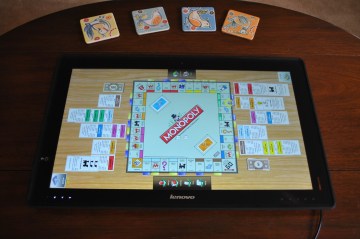For better or worse, most nights at the Newman household wind down with screens in our faces. My wife checks e-mail or does a crossword on her laptop. I fiddle with a tablet. The TV plays Yankee baseball or a recent episode of The Daily Show/Colbert Report in the background.
Last night was a little different. We played Connect Four, then Othello, then Monopoly — with a screen in our faces. Instead of playing the old-fashioned way, we were enjoying our board games on a 27-inch touch display, laid flat on the coffee table.
The screen in question was a Lenovo IdeaCentre Horizon 27″ Table PC, which the company sent over for review. For its size, it’s a reasonably thin all-in-one PC running Windows 8. Its built-in kickstand is quite stiff, so you can adjust the screen to any angle. It also has a built-in battery with about two hours of juice, so you can temporarily unplug it or relocate to another outlet without shutting the computer down.
I’ll have more to say about the IdeaCentre Horizon in a few weeks, after I’ve spent more time with it. But it’s already convinced me of one thing: I want gigantic screens like this all over the house. I want them in the kitchen, the living room and even the bedroom in place of a television. Heck, let’s throw one in the bathroom too.
I’m not saying I want huge computer screens in my face all the time — my wife would never approve, for one thing — but I’d love the option to have one wherever I happen to be.
Smartphones and tablets only go so far. You have to hold them up close to see what you’re doing, and their size limits how much information they show on the screen. The smaller screen also makes it harder to have shared experiences with other people, like playing a board game or looking at photos.
With a tablet, you must always crane your neck forward or hold the device up in your arms. You can’t lean back with a wireless keyboard or mouse and view the desktop version of Gmail or Tweetdeck. You can’t plug in a controller, kick your feet up and play Far Cry 3: Blood Dragon.
In a way, I’m just extolling the virtues of a desktop PC compared to a tablet or laptop. But the interesting thing about Lenovo’s tabletop PC is that it begs to be liberated from your office. You can unplug it and bring it into the living room. If I were to get one myself, I’d want to somehow build it into a coffee table, or give it its own side table–a companion to the television and everything else.
Thing is, Lenovo’s IdeaCentre Horizon isn’t exactly what I’m after. It’s pretty heavy and doesn’t last long on a charge, so you can’t really tote it around with you throughout the day. You could buy a few of them to place in various rooms, but at a base price of $1,699 (or $1,499 at Best Buy next month), that’s not a reasonable option, either.

What I really want is a bunch of smart screens around the house, to which I can beam a signal from my phone or tablet. The screens themselves would be less expensive than full-blown PCs, and they could remain stationary, plugged into their own power sources. They’d just act as larger interfaces for the computer I’m already carrying around.
Granted, the idea of using your phone as a computing hub has been a tech industry pipe dream for years. But so far, the companies who’ve tried it have only focused on powering laptops and tablets through clumsy docking stations. Nobody wants an underpowered PC that renders the phone unavailable, so the idea hasn’t taken off.
Larger screens in various parts of the house would make more sense, because they wouldn’t have to replace our workhorse laptops and tablets. Instead, they’d be supplemental, serving as larger windows into your apps and services wherever you happen to be.
It’s going to be a while before this idea is feasible. We need better wireless display technology, with lower latency than current solutions. We need screens that support wireless beaming, touch controls and other input technologies, such as motion control. Companies like Apple, Google and Microsoft need to build this type of large-screen control into their software. (Screen mirroring in Apple’s AirPlay is a start, but it doesn’t support touch or gesture controls on the larger display.)
For now, I’m content with one massive screen — lest I sound bratty for dreaming of the future. I’m looking forward to spending more time with the IdeaCentre Horizon as is, even if it means hauling it from one room to another just to approximate what may come.

